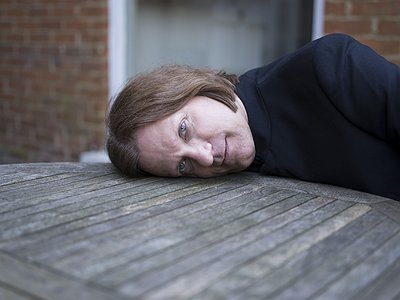Part 1
Name: Guy Sigsworth
Nationality: British
Occupation: Composer, producer and songwriter
Current Release: STET on Mercury KX
Recommendations: I’ve been deeply inspired by Derek Jarman’s diaries, “Smiling In Slow Motion”. I don’t think they count as “great literature”, but they show how inspiringly productive Jarman managed to be, even when he was terminally ill.
Another book I love to bits is “The Apollonian Clockwork”, by Elmer Schönberger and Louis Andriessen. It’s two Dutch composers, both hyper-fans of Stravinsky, going round the world visiting places where he lived and worked, discussing his music. Wonderful.
Website / Contact: If you enjoyed this interview with Guy Sigsworth, visit his website or twitter account for updates, background information and music.
When did you start writing/producing music - and what or who were your early passions and influences? What what is about music and/or sound that drew you to it?
When I was very young I tried to compose music on music paper. I drew squiggles which looked vaguely like music, and called the result “Symphony No. 1 in Eb”. I wasn’t hearing the sounds. I just loved the look.
My first musical love was the organ music of J.S. Bach. From there I headed ever further back in time. I became obsessed with the recordings of David Munrow, especially his “The Art Of Courtly Love”; 14th century love songs played on cornett, shawm, crumhorn, rebec, harp, and portative organ. I loved all the unfamiliar instrumental colours, and the Indiana Jones-like excitement I got from feeling like a musical explorer. That love of unfamiliar colours has stayed with me, even if what I do no longer fits into even a generous definition of “early music”.
For most artists, originality is first preceded by a phase of learning and, often, emulating others. What was this like for you? How would you describe your own development as an artist and the transition towards your own voice? What is the the relationship between copying, learning and your own creativity?
Everyone starts by emulating what they love, and so did I. But our emulations fail. Hopefully we fail in intriguing ways; we “fail better”. In art, failure and misunderstanding are more fruitful than accurate reproduction and omniscience; because, in art, nothing’s ever really wrong.
What were your main compositional- and production-challenges in the beginning and how have they changed over time?
I started with almost no equipment; an Atari computer, a sampler and a synth. My initial challenge was to discover the most distinctive, personal sounds I could with my three toys. Now I have a lot more toys, but the challenge is the same.
What was your first studio like? How and for what reasons has your set-up evolved over the years and what are currently some of the most important pieces of gear for you?
My first studio was just a table in my brother’s living room. Now I have an acoustically treated studio, which is obviously better. I suspect my most vital pieces of equipment are the most mundane. A really comfortable chair and a screen which doesn’t give me eyestrain have both helped me far more than my £10,000 microphone has. I need to work in rooms with natural light. Some producers are like vampires; they positively thrive in the vitamin D deprived environment of a bunker under a railway bridge. Not me. “Light. More light.”
How do you make use of technology? In terms of the feedback mechanism between technology and creativity, what do humans excel at, what do machines excel at?
The technology doesn’t have taste or judgement. It doesn’t even know it’s making music. That might change when we reach the AI singularity. Until then, everything still depends on us. The software developers of today face the same challenges as the great luthiers and violin-makers of the past. They have to craft DAWs, soft synths and plug-ins which fit the needs and whims of us frail human users. I have three different soft synths which seek to emulate the classic Minimoog. And again, they all fail to replicate in interesting ways. They all sound quite different, and they all feel quite different to use. Human-friendly design still matters, even in digital.
At the same time, our musical perception has been completely transformed by hearing software-performed music. Nowadays it can feel as if every human performer is vainly trying to outrun the algorithms, vainly trying to convince the audience they’re as in-tune as Hatsune Miku, or as rhythmically precise as an 808; they’re vainly trying to pass a kind of reverse Turing Test.
Chess grandmaster Gary Kasparov already lost to IBM’s Deep Blue some 20 years ago. So maybe we should re-think our interaction with technology. We need to be flexible. There are teams who play freestyle computer chess by continuously switching programs. They spot that their opponent is using Program A, so they quickly switch to Program B to gain a tactical advantage; that sort of thing. I don’t want to push this chess-music analogy too far, but what they’re doing is like making music with multiple DAWs. You know Ableton is good for one thing, Logic for another, and Pro Tools for another. So you hot-swap constantly. You stay ahead of the machines by getting to know each one of them better.
Production tools, from instruments to complex software environments, contribute to the compositional process. How does this manifest itself in your work? Can you describe the co-authorship between yourself and your tools?
I start from a clear aesthetic preference, and I look for instruments and software which can help me on my journey. For instance, I love effects which use FFT-type processes in very audible ways; I’ll buy any plug-in which says “Spectral” in its title. I also like physical modelling technology. A modelled piano in Pianoteq may not emulate an acoustic piano perfectly, but it can be made to morph in real time in ways no acoustic piano ever could.
My aesthetic is about placing sounds on the boundary of the real and the unreal; between the acoustic and the acousmatic. I love Viktor Shklovsky’s concept of остранение, or “defamiliarisation”. It’s a constant source of inspiration to me.
Collaborations can take on many forms. What role do they play in your approach and what are your preferred ways of engaging with other creatives through, for example, file sharing, jamming or just talking about ideas?
All of the above, from close-up jamming to file sharing across continents. “STET” features three approaches. The songs with Anil Sebastian mostly come from both of us working together in the same space. The song with Martin Grech is a classic “correspondence course” collaboration; I sent him a backing track, and he returned me a complete, recorded vocal. “Shurayo”, co-written with Mika Uchizato, almost counts as field recording, because I realised I had to go and experience the Ryukyu Islands directly with a Ryukyan artist in order to take the music further.






